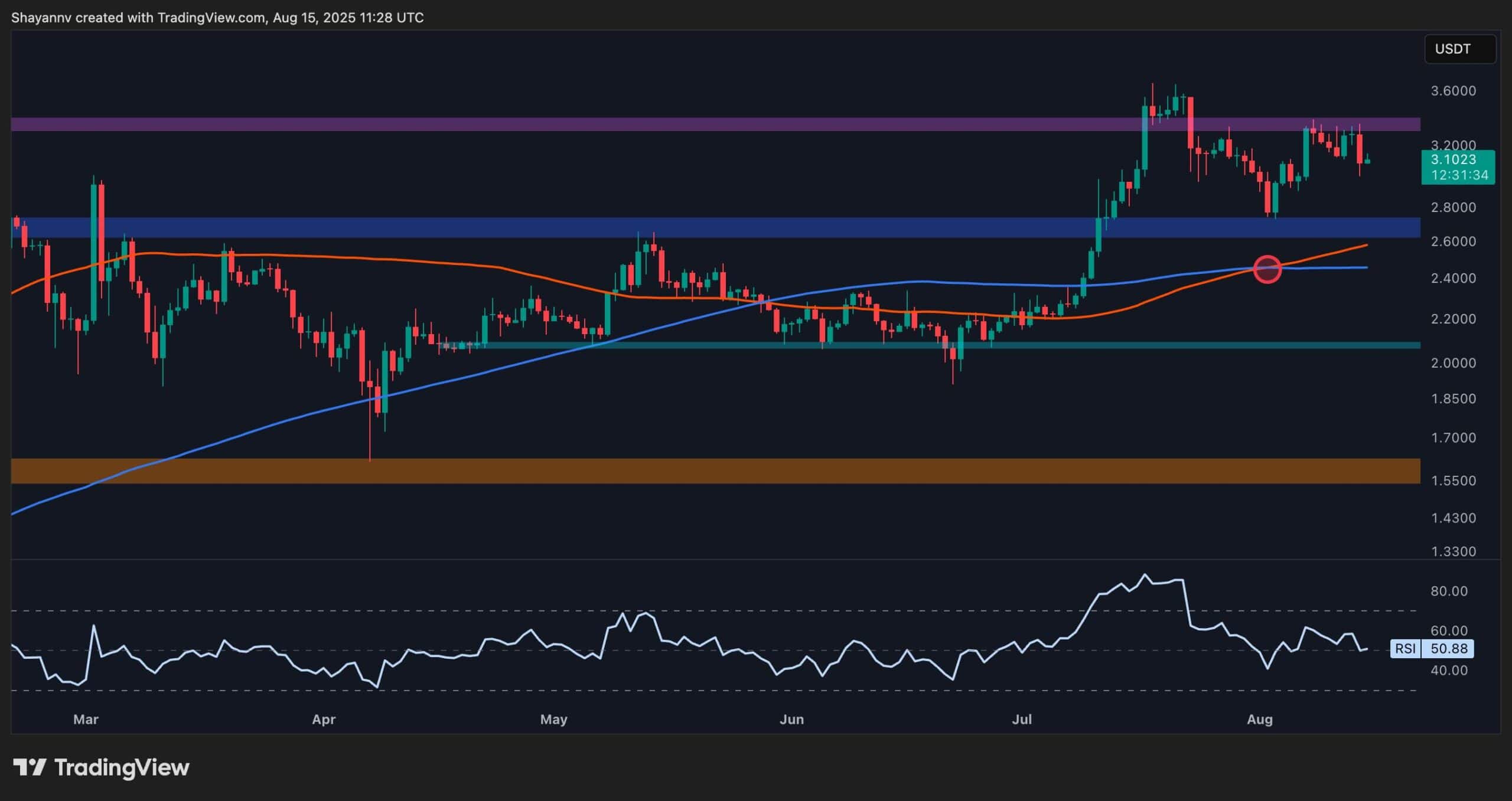Cryptocurrency
5 Bearish and 4 Bullish Factors for Bitcoin (BTC) in September

The world’s leading cryptocurrency has traded in a sideways channel ever since the early 2024 Bitcoin ETF rally.
Market bulls started it in earnest in October as a result of premature reports that SEC approvals were around the corner.
After that, BTC went from $27,000 on Oct. 14 to an all-time record high of almost $74,000 on Mar. 14. That represented a 170% gain for crypto investors in just five months.
The United States Securities and Exchange Commission approved 11 Bitcoin ETFs on Jan. 10, 2024. SEC Chair Gary Gensler said, “Investors should remain cautious about the myriad risks associated with bitcoin and products whose value is tied to crypto.”
The Bitcoin ETF rally delivered a whopping average annualized ROI of 415%. It was by far not the first time the largest cryptocurrency delivered eye-popping returns.
Also, by far, it was not the most BTC has returned to investors over comparable timeframes in previous markets over the past 15 years of its existence as an open-source blockchain operating over the Internet.
However, since peaking in March, bitcoin has traded sideways in a rangebound channel. So when will April’s halving supply cut kick in and touch off another rally based on BTC’s limited inventories?
The market is in different waters, to be sure, with the asset reaching a new ATH before its halving. That hasn’t happened in previous cycles. Regardless, there are signs this bull has room left to run.
But first, here are the headwinds Bitcoin’s price faces in September:
1. $33B Government Supply Overhang
According to crypto research company Kaiko, there is the looming threat of a $33 billion BTC supply glut because several governments have stashes they might offload, plus recovered Mt. Gox funds are being restored to their owners.
History from earlier this year showed us that when authorities and former users of the defunct crypto exchange decide to dispose of their assets, BTC’s price suffers.
2. Bitcoin ETF Paper Hands
Bitcoin purists like Andreas Antonopoulos warned about this years ago. Now that Wall Street is interested in cryptocurrency, its buying and selling pressure affects the price.
September is usually a month of selling on Wall Street. Since 1950, stocks returned investors an average loss of 0.7%, making it the worst month for the asset class.
The selling has already started in Bitcoin ETF markets, which saw outflows for four consecutive days from Aug. 27 through 30, totaling $454 million, according to Farside data.
3. Bitcoin Cyclical September Doldrums
Crypto has been no different from stocks in its short history. Bitcoin has only generated positive returns in September three times in the last decade. This seasonal trend could affect prices this year.
4. US Election Jitters
This four-year U.S. political cycle usually leaves financial markets uncertain until democracy has prevailed again with another peaceful transition of power and more policy certainty. The big money waits to make its moves until after election day.
5. Post-Halving Consolidation
Markets are right in the timeframe after previous halvings when bitcoin’s price tends to decline before rallying to new all-time highs.
Once all the sellers shake out and BTC finds its post-halving bottom, the bulls take over and run it up to new heights.
While bitcoin markets may have tough waters ahead based on the factors listed above, here are four long-term BTC price supports for bulls and bears to consider:
1. Financial Tailwinds for Bitcoin’s Price
The Fed is pivoting to low rates. This is bitcoin’s time to shine.
The US Federal Reserve sets the tone for the global financial economy by adjusting target interest rates for the supply of new dollars through daily lending markets in time with prices and employment.
Now that the Fed has called for rate cuts to shore up slowing labor markets with post-pandemic inflation, interest rates will begin to fall again, and prices are likely to start rising.
The way the credit economy works usually causes that wave of rising prices to happen first and with the most force in financial markets like the New York Stock Exchange and NASDAQ.
The more liquid the market for a trading asset and the more high-growth its future prospects are, the more leverage it tends to move against the benchmark change in interest rates.
That goes for bitcoin big time. For the previous three supply cycles, the daily new issuance was cut by half every four years. One year after the 2012 halving, BTC was up 50,000%. About 18 months after the 2016 halving, it had gone up 8,500%.
Federal interest rates were functionally zero percent during the entire post-2012 halving bitcoin bull market. However, BTC still delivered market-whopping alpha compared to stocks in the 2016 cycle. The Fed began steadily hiking rates in late 2015, reaching 2.4% by mid-2019.
Bitcoin surged to above $64,500 on Sunday, Aug. 25, after Fed Chair Jerome Powell announced on Friday that the central bank would soon begin cutting interest rates.
Over the week, BTC corrected but found support at $58,000 instead of falling as low as $55,000 as it did in the last two big corrections in August and July. That could signal the Fed pivot is emboldening long-term bulls.
2. Bitcoin Goes to Washington
The embrace of BTC by both U.S. political parties is very promising for long-term price support.
As markets grow more assured that the United States government groks bitcoin and has the will to back the crypto industry, the more calculated the risks are for the rewards of innovating and capitalizing valuable contributions in the blockchain space.
Crypto expert Andrea Barbon, a Swiss University of St. Gallen finance professor, recently told Forbes:
“While bitcoin has often been viewed as a hedge against economic turmoil, its future performance could hinge on the upcoming U.S. elections. So far, Donald Trump has been more supportive of crypto, and a return to the White House could bring regulatory shifts that favor digital assets.”
But regardless of how Republicans and Democrats parcel up the levers of power this November, crypto companies are beginning to wield enormous influence in Washington.
They have made the most political donations in 2024, according to a report by Public Citizen, a non-profit D.C. consumer advocacy watchdog.
3. Bullish Smart Money
Participants representing the smart money in crypto, for example — MicroStrategy co-founder Michael Saylor and Blockstream CEO Adam Back — are outlandishly bullish for BTC this cycle.
Saylor recently confirmed in August that he personally owns bitcoin in an amount worth some $1 billion at the current market prices.
Adam Back, meanwhile, has an $80,000 BTC price target in view.
Back commented in late August that financial company Cantor Fitzgerald’s $194 target for MicroStrategy stocks implies an $80,000 BTC price.
That would represent a 33% gain for the asset over its $60,000 long-term support level since March. Why is smart money betting on further price increases of this magnitude for bitcoin?
Because they believe the most securely scarce cryptocurrency is poised to become a major world reserve for massive private and public treasuries to engage in international trade.
4. Bullish BTC Technical Indicators
Bitcoin markets gathered strength to the upside last week, with exchanges increasing in volume as bulls took the price above $65,000, according to data from CoinMarketCap.
That enthusiastic buy-up following the Fed’s interest rate announcement is an early signal of the market’s demand for the asset as rates go down and prices increase.
Bitcoin and altcoin chart analyst Mister Crypto posted to over 118K followers on X Tuesday that he expects to see an enormous parabolic move for BTC sometime in the near future.
Highlighting the descending flag pattern on bitcoin’s chart from March through August, often a bullish continuation pattern during a broader uptrend, Mister Crypto asked, “Would you believe me if I told you this #Bitcoin breakout has a target of $93,000?”
Earlier in August, the crypto investor said it is very likely that bitcoin’s price will return to the $68,000 level in the short term now that it has broken above $64,000.
Binance Free $600 (CryptoPotato Exclusive): Use this link to register a new account and receive $600 exclusive welcome offer on Binance (full details).
LIMITED OFFER 2024 at BYDFi Exchange: Up to $2,888 welcome reward, use this link to register and open a 100 USDT-M position for free!
Cryptocurrency
Ethereum Foundation, Whales, and Hackers: What’s Driving the ETH Sell-Off?

TL;DR
- Whales, hackers, and the Ethereum Foundation wallets moved over $500M in ETH through large sales and withdrawals.
- Ethereum transfers rose to 4.6M ETH, nearing the monthly high of 5.2M recorded in July.
- Staking inflows hit 247,900 ETH, the highest in a month, locking more supply from trading.
Large Withdrawals and Whale Activity
Ethereum (ETH) has seen heavy movement from major wallets over the past few days. On-chain data from Lookonchain shows a newly created wallet pulled 17,591 ETH, worth $81.62 million, from Kraken in just two hours.
Over three days, two new wallets withdrew a combined 71,025 ETH, valued at $330 million, from the exchange.
One of these wallets, address 0x2A92, has withdrawn 53,434 ETH, worth $242.34 million, in two days. This includes a recent purchase of 30,069 ETH, valued at $138.46 million, during a market drop.
Major ETH Holders Offload Millions Amid Price Rally
In contrast, several separate entities have been disposing of some ETH holdings. A wallet tied to a hacker address 0x17E0 sold 4,958 ETH for $22.13 million at $4,463, securing a profit of $9.75 million. Earlier this year, the same address sold 12,282 ETH at $1,932 and later bought back part of the amount at higher prices.
A different whale sold 20,600 ETH for $96.55 million over the past two days, generating a profit of more than $26 million after holding the position for nine months.
Meanwhile, an Ethereum Foundation-linked wallet, 0xF39d, sold 6,194 ETH worth $28.36 million in the last three days at an average price of $4,578.
Recent sales from the same wallet included an additional 1,100 ETH and 1,695 ETH for over $12.7 million combined.
The #EthereumFoundation-linked wallet(0xF39d) sold another 1,300 $ETH($5.87M) at $4,518 ~11 hours ago.
Over the past 3 days, this wallet has sold a total of 6,194 $ETH($28.36M) at an average price of $4,578.https://t.co/4hfCWymHVG pic.twitter.com/ErUyEY8SJy
— Lookonchain (@lookonchain) August 15, 2025
Network Activity on the Rise
CryptoQuant data shows Ethereum’s total tokens transferred have been climbing since August 9. After ranging between 1 million and 3 million ETH through late July and early August, transfers have risen to 4.6 million ETH, approaching the monthly high of 5.2 million recorded in mid-July. This increase has occurred alongside a price rally from about $3,400 to $4,600.
Interestingly, staking inflows generally stayed between 20,000 and 80,000 ETH per day over the past month. On August 14, inflows jumped to 247,900 ETH, the highest in the period.
At the time, ETH was trading near $4,600. Large staking deposits reduce the amount of ETH available for immediate trading, as staked coins are locked for a set period.
In the meantime, ETH trades at $4,647 with a 24-hour volume of $68.25 billion, down 2% on the day but up 19% over the week.
Binance Free $600 (CryptoPotato Exclusive): Use this link to register a new account and receive $600 exclusive welcome offer on Binance (full details).
LIMITED OFFER for CryptoPotato readers at Bybit: Use this link to register and open a $500 FREE position on any coin!
Cryptocurrency
Massive DOGE Whale Activity Hints at $1 Breakout

TL;DR
- Whales bought two billion DOGE this week, lifting their combined holdings to 27.6 billion coins.
- A single 900M DOGE transfer worth $208M to Binance drew attention to large exchange movements.
- DOGE broke key resistance, with momentum building for a possible push toward the $1 price mark.
Price and Market Moves
Dogecoin (DOGE) traded at $0.23 at press time, slipping 4% over the past day but still showing a 2% gain for the week. Daily turnover came in at about $6.18 billion.
Meanwhile, the broader crypto market saw over $1 billion in liquidations. Hotter-than-expected US Producer Price Index data pushed traders to scale back expectations of a near-term Federal Reserve rate cut. DOGE had roughly 290,500 coins liquidated during the sell-off.
On the two-week chart, analyst Trader Tardigrade notes that DOGE has cleared a downward-sloping resistance line after completing what appears to be a “wave V” in an Elliott Wave sequence. Similar setups in the past, where prolonged declines stayed within falling channels before breaking higher, have been followed by sharp rallies.
$Doge/2-week#Dogecoin is gaining strong momentum to surge above $1 pic.twitter.com/TuSEKr19nv
— Trader Tardigrade (@TATrader_Alan) August 15, 2025
Momentum gauges are also turning up. The Stochastic RSI, which had dropped into oversold territory, is now heading higher. Previous reversals from this zone have coincided with sustained upward moves. The current formation points to a possible run that could carry DOGE past the $1 mark.
Heavy Whale Buying and Large Transfers
As reported by CryptoPotato, blockchain data shows large investors have added two billion DOGE in the past week, spending just under $500 million. That brings their holdings to about 27.6 billion coins, or 18% of the supply. The buying streak has prompted speculation within the community.
Recently, Whale Alert flagged a 900 million DOGE transfer worth about $208 million into Binance. The tracking indicates that it originated from a wallet connected to the exchange, likely as an internal activity. The address involved holds 2.88 billion DOGE, one of the largest balances on the network.
Ali Martinez also reports that transactions above $1 million reached a one-month high, with activity building since early August and peaking as DOGE traded at $0.25.
Whales are back! Dogecoin $DOGE activity at a 1-month high. pic.twitter.com/C83Pv68mCt
— Ali (@ali_charts) August 14, 2025
Sentiment Building
Analyst Gordon described the current setup as “a nice bit of consolidation” before a potential breakout, adding,
“This will be one of the first coins normies FLOCK to & the pump will be MASSIVE.”
With whale accumulation rising, high-value transfers increasing, and a bullish technical pattern in play, DOGE is positioned for a potential push toward $1 if momentum holds.
Binance Free $600 (CryptoPotato Exclusive): Use this link to register a new account and receive $600 exclusive welcome offer on Binance (full details).
LIMITED OFFER for CryptoPotato readers at Bybit: Use this link to register and open a $500 FREE position on any coin!
Cryptocurrency
Ripple Price Analysis: XRP at Risk as Key Support Levels Could Trigger Sharp Drop

XRP has recently entered a consolidation phase after a strong rally earlier this summer, with the price action now hovering around key resistance levels on both its USDT and BTC pairs. Yet, while momentum has slowed, the charts still indicate a generally bullish structure, with multiple key support levels remaining firmly in place.
Technical Analysis
By ShayanMarkets
The USDT Pair
On the XRP/USDT daily chart, the price is currently trading near the $3.10 mark, facing a strong resistance zone around $3.40. This follows a breakout above the $2.70 range in July, which has now flipped into a support area.
Both the 100-day and 200-day moving averages are also trending upward and recently formed a bullish crossover around $2.45, reinforcing the medium-term bullish sentiment. If the $3.40 resistance breaks, a push toward the critical $4.00 range becomes likely.
However, the RSI hovering near the neutral 50 level suggests a lack of strong momentum for now, meaning a short-term pullback into the $2.80 support zone is still possible.
This zone will be key for maintaining the bullish structure. Losing it could open the door for a deeper correction toward the 200-day moving average located around the $2.40 mark. Yet, as long as the price stays above the moving averages, the broader trend remains bullish.
The BTC Pair
Looking at the XRP/BTC chart, the pair has recently pulled back after hitting the 3,000 SAT resistance, with the price currently around 2,600 SAT.
This follows a clean breakout above the long-term descending channel and a successful retest of its upper boundary, which coincided with the 200-day moving average and the 2,400 SAT support zone. This confluence remains a key bullish technical factor, as holding above it could attract renewed buying pressure.
That said, RSI levels around 48 show that momentum has cooled after the sharp July rally, meaning XRP may continue ranging between 2,400 SAT and 3,000 SAT in the near term. A decisive close above 3,000 SAT would likely open the path to the 3,400 SAT zone, while losing 2,400 SAT could shift the bias back toward 2,000 SAT support. For now, the structure still favors the bulls as long as higher lows remain intact.
Binance Free $600 (CryptoPotato Exclusive): Use this link to register a new account and receive $600 exclusive welcome offer on Binance (full details).
LIMITED OFFER for CryptoPotato readers at Bybit: Use this link to register and open a $500 FREE position on any coin!
Disclaimer: Information found on CryptoPotato is those of writers quoted. It does not represent the opinions of CryptoPotato on whether to buy, sell, or hold any investments. You are advised to conduct your own research before making any investment decisions. Use provided information at your own risk. See Disclaimer for more information.
Cryptocurrency charts by TradingView.

 Forex3 years ago
Forex3 years agoForex Today: the dollar is gaining strength amid gloomy sentiment at the start of the Fed’s week

 Forex3 years ago
Forex3 years agoUnbiased review of Pocket Option broker

 Forex3 years ago
Forex3 years agoDollar to pound sterling exchange rate today: Pound plummeted to its lowest since 1985

 Forex3 years ago
Forex3 years agoHow is the Australian dollar doing today?

 Cryptocurrency3 years ago
Cryptocurrency3 years agoWhat happened in the crypto market – current events today

 World3 years ago
World3 years agoWhy are modern video games an art form?

 Commodities3 years ago
Commodities3 years agoCopper continues to fall in price on expectations of lower demand in China

 Economy3 years ago
Economy3 years agoCrude oil tankers double in price due to EU anti-Russian sanctions





















